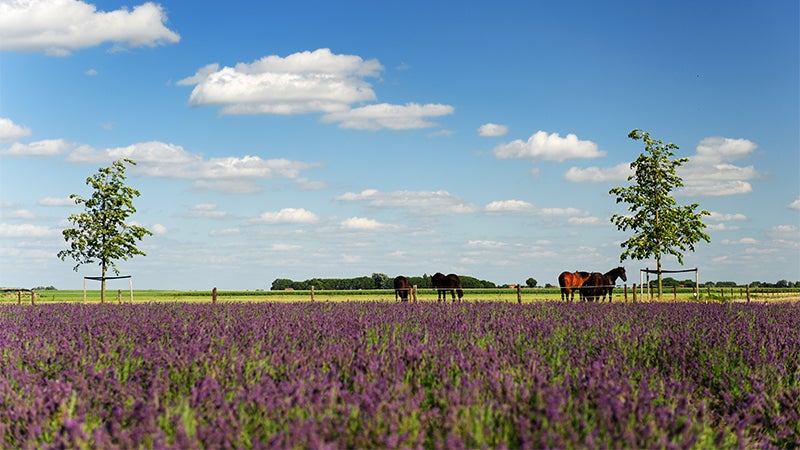Horses & Aromatherapy
Published 8:18 pm Thursday, August 31, 2017
Throughout the years, horses have been a major part of the Blue Ridge Foothills for tourism and culture alike. The caretakers of these phenomenal animals do their best to keep them as healthy and comfortable as possible and one way to do so is through the numerous benefits of aromatherapy.
Essential oils and scent therapy have been proven to help many people through a variety of everyday problems, but the ways that aromatherapy can positively affect animals – especially larger animals, such as horses and ponies – are less well known, although just as significant.
Essential oils can help animals both physically and mentally, affecting their behaviors and bodies in a positive manner (when used correctly).
Lavender (Lavandula angustifolia) can be used for stressed or anxious animals. It has a significant stabilizing effect on horses that can help calm them and relieve tension. With horses that experience respiratory problems, Cajeput (Melaleuca Cajeputi Powell) can help to clear their lungs and allow them to breathe more freely, as well as help put a stop to compulsive or unhealthy habits (such as cribbing).
Digestive problems can be eased by Sweet Orange essential oil (Citrus Sinensis), which is a non-irritant and acts as a way to help stomach issues and nervousness. However, a mixture of different types of oils can allow them to perform many functions at the same time, and cure more complex problems or intensify its results.
Aromatherapy’s effect on animals is anything but subtle. In racing, horses aren’t allowed to be given peppermint oil at risk of disqualification, because peppermint has been proven to give them a significant burst of energy that may lead to an unfair advantage.
Natural remedies, although often seen as “diluted” or more simple versions of complex medicines and practices, can show obvious results and temporarily cure common ailments. The essential oils should be diffused and inhaled through the nose, or be taken in through the hair or skin. However, due to these often extremely effective results, aromatherapy should be handled with caution and extensive research on the right types of oils, how to use them, and whether they’re safe for horses or other animals.
When considering the use of a certain oil or scent, the correct carrier oil must be paired along with it in order to better protect the horse’s safety. Carrier oils help to make the effects of the oil less harsh and prevent them from irritating the skin or causing unwanted side effects. Horses can be especially sensitive to essential oils, and special precautions should be taken to assure that they don’t ingest them. Incorrect or careless usage may quickly lead to sensitive skin, or a worsening of the condition that the oil was meant to ease.
When mixing oils, make sure to follow a recipe or do research into the reactions between different herbs and scents to avoid unwanted reactions between the oils. However, once proper research and professional consultations with an expert have been taken, the use of aromatherapy may be well worth it to both the horse and its caretaker.
Aromatherapy can make a horse’s life more comfortable, which, in turn, makes its owner’s life easier. Beyond convenience, a horse and its owner are often inseparable, and seeing one’s animal unhappy to any degree can be saddening. Irritated or uncomfortable horses are very hard to work with, and although larger problems or diseases should be aided with the help of a veterinarian, essential oils can be a natural way to help smaller problems and make a horse owner’s job easier. •
Stress & Anxiety Spray
2 oz. glass spray bottle
1 oz. rubbing alcohol
1 oz. fractionated coconut oil
Essential Oils
30 drops of Lavender
10 drops of Roman Chamomile
5 drops of Rose Geranium
5 drops of Sweet Orange
DIRECTIONS:
First, place the essential oils into the spray bottle. Be sure to drop the oil in even amounts in order to assure that the ratios are correct. Drop with a steady hand and count diligently. Next, incorporate the rubbing alcohol and fractionated coconut oil, again making sure that the amounts are as accurate and exact as possible. Screw the lid on tightly, shake well, and mist onto the horse, avoiding the eye area. Be sure, before use, that the bottle has been shaken well enough that all components become one mixture, so that the oils can blend together and perform all intended uses.
Horse Fly Repellant Spray
2 oz. glass spray bottle
1 oz. distilled water
1 oz. alcohol
Essential Oils
30 drops of Basil
30 drops of Tea Tree
25 drops of Rose Geranium
DIRECTIONS:
Place your essential oils into the glass bottle first. This ensures the oils mix properly. Next, add the distilled water and alcohol. Close the lid tightly, shake well, and mist onto your horse. This recipe is a wonderful, non-toxic blend with a pleasant fragrance. Although this mixture won’t directly affect the horse itself as far as behavior and bodily functions go, it will keep away pests and save it from painful bites and annoyance.
Amanda Edwards is a certified aromatherapist, member of the National Association for Holistic Aromatherapy, and owner of her own company, Juniper Jade Essentials. Amanda lives in Tryon, N.C. with her husband and two children. She writes a lifestyle blog at www.myblueridgelife.com.






